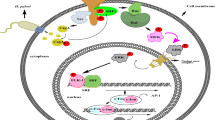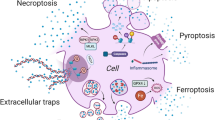Abstract
Purpose
Tumor necrosis factor-α inducing protein (Tipα) is a unique carcinogenic factor released from Helicobacter pylori (H. pylori). Tipα specifically binds to cells and is incorporated into cytosol and nucleus, where it strongly induces expression of TNF-α and chemokine genes mediated through NF-κB activation, resulting in tumor development. To elucidate mechanism of action of Tipα, we studied a binding protein of Tipα in gastric epithelial cells.
Methods
Tipα binding protein was found in cell lysates of mouse gastric cancer cell line MGT-40 by FLAG-pull down assay and identified to be cell surface nucleolin by flow cytometry using anti-nucleolin antibody. Incorporation of Tipα into the cells was determined by Western blotting and expression of TNF-α gene was quantified by RT-PCR.
Results
Nucleolin was co-precipitated with Tipα-FLAG, but not with del-Tipα-FLAG (an inactive mutant). After treatment with Tipα-FLAG, incorporated Tipα was co-immunoprecipitated with endogenous nucleolin using anti-nucleolin antibody. The direct binding of Tipα to recombinant His-tagged nucleolin fragment (284–710) was also confirmed. Although nucleolin is an abundant non-ribosomal protein of the nucleolus, we found that nucleolin is present on the cell surface of MGT-40 cells. Pretreatment with anti-nucleolin antibody enhanced Tipα-incorporation into the cells through nucleolin internalization. In addition, pretreatment with tunicamycin, an inhibitor of N-glycosylation, decreased the amounts of cell surface nucleolin and inhibited both internalization of Tipα and expression of TNF-α gene.
Conclusions
All the results indicate that nucleolin acts as a receptor for Tipα and shuttles Tipα from cell surface to cytosol and nuclei. These findings provide a new mechanistic insight into gastric cancer development with Tipα.





Similar content being viewed by others
Abbreviations
- H. pylori :
-
Helicobacter pylori
- Tipα:
-
TNF-α inducing protein
- CagA:
-
Cytotoxin associated antigen
- LC–MS:
-
Liquid chromatography–mass spectrometry
- RBD:
-
RNA binding domain
- NF-κB:
-
Nuclear factor-kappa B
- NEMO:
-
NF-κB essential modulator
References
Balkwill F (2009) Tumour necrosis factor and cancer. Nat Rev Cancer 9:361–371
Barel M, Hovanessian AG, Meibom K, Briand JP, Dupuis M, Charbit A (2008) A novel receptor—ligand pathway for entry of Francisella tularensis in monocyte-like THP-1 cells: interaction between surface nucleolin and bacterial elongation factor Tu. BMC Microbiol 8:145
Borer RA, Lehner CF, Eppenberger HM, Nigg EA (1989) Major nucleolar proteins shuttle between nucleus and cytoplasm. Cell 56:379–390
Carpentier M, Morelle W, Coddeville B, Pons A, Masson M, Mazurier J, Legrand D (2005) Nucleolin undergoes partial N- and O-glycosylations in the extranuclear cell compartment. Biochemistry 44:5804–5815
El-Omar EM, Carrington M, Chow WH, McColl KE, Bream JH, Young HA, Herrera J, Lissowska J, Yuan CC, Rothman N, Lanyon G, Martin M, Fraumeni JF Jr, Rabkin CS (2000) Interleukin-1 polymorphisms associated with increased risk of gastric cancer. Nature 404:398–402
El-Omar EM, Rabkin CS, Gammon MD, Vaughan TL, Risch HA, Schoenberg JB, Stanford JL, Mayne ST, Goedert J, Blot WJ, Fraumeni JF Jr, Chow WH (2003) Increased risk of noncardia gastric cancer associated with proinflammatory cytokine gene polymorphisms. Gastroenterology 124:1193–1201
Ginisty H, Sicard H, Roger B, Bouvet P (1999) Structure and functions of nucleolin. J Cell Sci 112(Pt 6):761–772
Girvan AC, Teng Y, Casson LK, Thomas SD, Juliger S, Ball MW, Klein JB, Pierce WM Jr, Barve SS, Bates PJ (2006) AGRO100 inhibits activation of nuclear factor-κB (NF-κB) by forming a complex with NF-κB essential modulator (NEMO) and nucleolin. Mol Cancer Ther 5:1790–1799
Godlewska R, Pawlowski M, Dzwonek A, Mikula M, Ostrowski J, Drela N, Jagusztyn-Krynicka EK (2008) Tip-α (hp0596 gene product) is a highly immunogenic Helicobacter pylori protein involved in colonization of mouse gastric mucosa. Curr Microbiol 56:279–286
Hirano K, Miki Y, Hirai Y, Sato R, Itoh T, Hayashi A, Yamanaka M, Eda S, Beppu M (2005) A multifunctional shuttling protein nucleolin is a macrophage receptor for apoptotic cells. J Biol Chem 280:39284–39293
Hoja-Lukowicz D, Przybylo M, Pochec E, Drabik A, Silberring J, Kremser M, Schadendorf D, Laidler P, Litynska A (2009) The new face of nucleolin in human melanoma. Cancer Immunol Immunother 58:1471–1480
Hovanessian AG (2006) Midkine, a cytokine that inhibits HIV infection by binding to the cell surface expressed nucleolin. Cell Res 16:174–181
Hovanessian AG, Puvion-Dutilleul F, Nisole S, Svab J, Perret E, Deng JS, Krust B (2000) The cell-surface-expressed nucleolin is associated with the actin cytoskeleton. Exp Cell Res 261:312–328
IARC Working Group on the Evaluation of Carcinogenic Risks to Humans (1994) Schistosomes, liver flukes and Helicobacter pylori. IARC Monogr Eval Carcinog Risks Hum 61:1–241
Ichinose M, Nakanishi H, Fujino S, Tatematsu M (1998) Establishment and characterization of two cell lines from N-methyl-N-nitrosourea-induced mouse glandular stomach carcinomas. Jpn J Cancer Res 89:516–524
Inoue K, Shiota S, Yamada K, Gotoh K, Suganuma M, Fujioka T, Ahmed K, Iha H, Nishizono A (2009) Evaluation of a new tumor necrosis factor-α-inducing membrane protein of Helicobacter pylori as a prophylactic vaccine antigen. Helicobacter 14:135–143
Ireson CR, Kelland LR (2006) Discovery and development of anticancer aptamers. Mol Cancer Ther 5:2957–2962
Jang JY, Yoon HJ, Yoon JY, Kim HS, Lee SJ, Kim KH, Kim DJ, Jang S, Han BG, Lee BI, Suh SW (2009) Crystal Structure of the TNF-α-inducing protein (Tipα) from Helicobacter pylori: insights into Its DNA-binding activity. J Mol Biol 392:191–197
Komori A, Yatsunami J, Suganuma M, Okabe S, Abe S, Sakai A, Sasaki K, Fujiki H (1993) Tumor necrosis factor acts as a tumor promoter in BALB/3T3 cell transformation. Cancer Res 53:1982–1985
Kuzuhara T, Suganuma M, Oka K, Fujiki H (2007) DNA-binding activity of TNF-α inducing protein from Helicobacter pylori. Biochem Biophys Res Commun 362:805–810
Legrand D, Vigie K, Said EA, Elass E, Masson M, Slomianny MC, Carpentier M, Briand JP, Mazurier J, Hovanessian AG (2004) Surface nucleolin participates in both the binding and endocytosis of lactoferrin in target cells. Eur J Biochem 271:303–317
Li T, Shi L, Wang E, Dong S (2009) Multifunctional G-quadruplex aptamers and their application to protein detection. Chemistry 15:1036–1042
Losfeld ME, Khoury DE, Mariot P, Carpentier M, Krust B, Briand JP, Mazurier J, Hovanessian AG, Legrand D (2009) The cell surface expressed nucleolin is a glycoprotein that triggers calcium entry into mammalian cells. Exp Cell Res 315:357–369
Moore RJ, Owens OM, Stamp G, Arnott C, Burke F, East N, Holdsworth H, Turner L, Rollins B, Pasparakis M, Kollias G, Balkwill F (1999) Mice deficient in tumor necrosis factor-α are resistant to skin carcinogenesis. Nat Med 5:828–831
Muramatsu T (2002) Midkine and pleiotrophin: two related proteins involved in development, survival, inflammation and tumorigenesis. J Biochem 132:359–371
Nisole S, Said EA, Mische C, Prevost MC, Krust B, Bouvet P, Bianco A, Briand JP, Hovanessian AG (2002) The anti-HIV pentameric pseudopeptide HB-19 binds the C-terminal end of nucleolin and prevents anchorage of virus particles in the plasma membrane of target cells. J Biol Chem 277:20877–20886
Okuda M, Nakazawa T, Yamauchi K, Miyashiro E, Koizumi R, Booka M, Teraguchi S, Tamura Y, Yoshikawa N, Adachi Y, Imoto I (2005) Bovine lactoferrin is effective to suppress Helicobacter pylori colonization in the human stomach: a randomized, double-blind, placebo-controlled study. J Infect Chemother 11:265–269
Peek RM (2008) Helicobacter pylori infection and disease: from humans to animal models. Dis Model Mech 1:50–55
Peek RM Jr, Blaser MJ (2002) Helicobacter pylori and gastrointestinal tract adenocarcinomas. Nat Rev Cancer 2:28–37
Reyes-Reyes EM, Akiyama SK (2008) Cell-surface nucleolin is a signal transducing P-selectin binding protein for human colon carcinoma cells. Exp Cell Res 314:2212–2223
Said EA, Krust B, Nisole S, Svab J, Briand JP, Hovanessian AG (2002) The anti-HIV cytokine midkine binds the cell surface-expressed nucleolin as a low affinity receptor. J Biol Chem 277:37492–37502
Shi H, Huang Y, Zhou H, Song X, Yuan S, Fu Y, Luo Y (2007) Nucleolin is a receptor that mediates antiangiogenic and antitumor activity of endostatin. Blood 110:2899–2906
Snaith A, El-Omar EM (2008) Helicobacter pylori: host genetics and disease outcomes. Expert Rev Gastroenterol Hepatol 2:577–585
Soundararajan S, Chen W, Spicer EK, Courtenay-Luck N, Fernandes DJ (2008) The nucleolin targeting aptamer AS1411 destabilizes Bcl-2 messenger RNA in human breast cancer cells. Cancer Res 68:2358–2365
Storck S, Shukla M, Dimitrov S, Bouvet P (2007) Functions of the histone chaperone nucleolin in diseases. Subcell Biochem 41:125–144
Suganuma M, Okabe S, Marino MW, Sakai A, Sueoka E, Fujiki H (1999) Essential role of tumor necrosis factor α (TNF-α) in tumor promotion as revealed by TNF-α-deficient mice. Cancer Res 59:4516–4518
Suganuma M, Kurusu M, Okabe S, Sueoka N, Yoshida M, Wakatsuki Y, Fujiki H (2001) Helicobacter pylori membrane protein 1: a new carcinogenic factor of Helicobacter pylori. Cancer Res 61:6356–6359
Suganuma M, Okabe S, Kurusu M, Iida N, Ohshima S, Saeki Y, Kishimoto T, Fujiki H (2002) Discrete roles of cytokines, TNF-α, IL-1, IL-6 in tumor promotion and cell transformation. Int J Oncol 20:131–136
Suganuma M, Kurusu M, Suzuki K, Nishizono A, Murakami K, Fujioka T, Fujiki H (2005) New tumor necrosis factor-α-inducing protein released from Helicobacter pylori for gastric cancer progression. J Cancer Res Clin Oncol 131:305–313
Suganuma M, Kuzuhara T, Yamaguchi K, Fujiki H (2006) Carcinogenic role of tumor necrosis factor-α inducing protein of Helicobacter pylori in human stomach. J Biochem Mol Biol 39:1–8
Suganuma M, Yamaguchi K, Ono Y, Matsumoto H, Hayashi T, Ogawa T, Imai K, Kuzuhara T, Nishizono A, Fujiki H (2008) TNF-α-inducing protein, a carcinogenic factor secreted from H. pylori, enters gastric cancer cells. Int J Cancer 123:117–122
Takagi M, Absalon MJ, McLure KG, Kastan MB (2005) Regulation of p53 translation and induction after DNA damage by ribosomal protein L26 and nucleolin. Cell 123:49–63
Tosi T, Cioci G, Jouravleva K, Dian C, Terradot L (2009) Structures of the tumor necrosis factor α inducing protein Tipα: a novel virulence factor from Helicobacter pylori. FEBS Lett 583:1581–1585
Tsuge H, Tsurumura T, Utsunomiya H, Kise D, Kuzuhara T, Watanabe T, Fujiki H, Suganuma M (2009) Structural basis for the Helicobacter pylori-carcinogenic TNF-α-inducing protein. Biochem Biophys Res Commun 388:193–198
Yoshida M, Wakatsuki Y, Kobayashi Y, Itoh T, Murakami K, Mizoguchi A, Usui T, Chiba T, Kita T (1999) Cloning and characterization of a novel membrane-associated antigenic protein of Helicobacter pylori. Infect Immun 67:286–293
Acknowledgments
We thank Ms. Kaori Suzuki and Ikuko Shiotani, Research Institute for Clinical Oncology, Saitama Cancer Center for their technical assistance. We also thank Dr. Masae Tatematsu for supplying of MGT-40 cells. This work was supported by Japan Society for the Promotion of Science, and Smoking Research Fund.
Author information
Authors and Affiliations
Corresponding author
Rights and permissions
About this article
Cite this article
Watanabe, T., Tsuge, H., Imagawa, T. et al. Nucleolin as cell surface receptor for tumor necrosis factor-α inducing protein: a carcinogenic factor of Helicobacter pylori . J Cancer Res Clin Oncol 136, 911–921 (2010). https://doi.org/10.1007/s00432-009-0733-y
Received:
Accepted:
Published:
Issue Date:
DOI: https://doi.org/10.1007/s00432-009-0733-y




